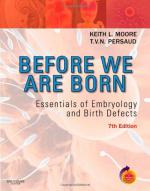|
This section contains 383 words (approx. 2 pages at 300 words per page) |
The term congenital is used to describe a condition or defect that exists at birth. Congenital disorders are present in the developing fetus. Sickle cell disease, Down syndrome, and congenital rubella syndrome are three examples of congenital conditions in humans. Congenital disorders result from abnormalities in the fetus's genetic inheritance, conditions in the fetal environment, or a combination of the two. Up to three percent of babies in the United States are born with a major congenital defect. Prenatal testing can detect some congenital conditions.
Many congenital conditions are caused by chromosomal disorders. A human fetus inherits 23 chromosomes from its mother and 23 chromosomes from its father, making a total of 23 pairs. An extra chromosome or a missing chromosome disturbs fetal development. Down syndrome, marked by mental retardation and a distinctive physical appearance, is caused by an extra chromosome.
Each chromosome carries many genes. Like chromosomes, genes are present in pairs. Genes are responsible for many inherited traits, including eye color and blood type. Genetic disorders are caused by abnormal genes. Sickle cell disease, a blood disorder, occurs when a fetus inherits an abnormal gene from each parent. Polydactyly, the presence of extra fingers or toes, occurs when an abnormal gene is inherited from one parent.
Some congenital disorders are caused by environmental factors. It may be that certain genetic combinations leave some fetuses more vulnerable to the absence or presence of certain nutrients or chemicals. Spina bifida, also known as "open spine," occurs when embryo development goes awry and part of the neural tube fails to close. Adequate amounts of folic acid, a vitamin, help prevent spina bifida. Cleft palate, a hole in the roof of the mouth, is another congenital defect that seems to be caused by multiple factors. Congenital rubella syndrome, marked by mental retardation and deafness, is present in newborns whose mothers contracted rubella (German measles) during pregnancy.
Prenatal testing can diagnose certain congenital disorders. Ultrasound, which uses sound waves to produce an image of the fetus, can discover some defects of the heart and other organs. Amniocentesis and chorionic villi sampling are procedures that remove fetal cells from within the pregnant uterus for genetic testing. These tests can determine the presence of Down syndrome, sickle cell anemia, cystic fibrosis, and other genetic diseases.
|
This section contains 383 words (approx. 2 pages at 300 words per page) |


